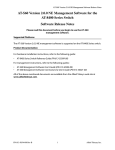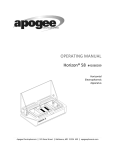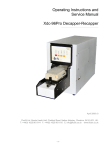Download - Frank`s Hospital Workshop
Transcript
Instruction Manual Mini Vertical Gel System 120-2 Gel and 120-4 Gel ! ▲ WARNING ▲ ▲ Please read these instructions carefully before using this apparatus. ! ▲ AVERTISSEMENT ▲ ▲ 450 Fortune Boulevard Milford, MA 01757 Tel: (508) 482-7000 FAX: (508) 634-2199 Email: [email protected] www.thermo.com 162-3000-00 Rev.E ©01/04 Printed in USA Veuillez, avant tout emploi du appareil, lire attentivement ce manuel d´utilisation. MINI VERTICAL GEL SYSTEM MINI VERTICAL GEL SYSTEM SAFETY NOTICES ▲ WARNING ▲ This Mini Vertical Gel System is designed to be used for electrophoretic separation techniques. The power required for these techniques is provided by an external electrophoresis power supply. The maximum operating limits for this chamber should not exceed 650 V and 30 watts; the maximum temperature that can be tolerated by the apparatus is 50 °C. Do not use the system without the safety cover. WARRANTY This laboratory equipment was produced by Thermo Electron with the highest practical standards of materials, workmanship, and design. The design and manufacture of parts have been conceived with one purpose — to produce a unit which will give satisfactory service. Thermo Electron guarantees this unit to be free from defects in materials or workmanship under normal use or service for one year from date of shipment.. If, during this time, this unit proves defective in materials or workmanship, the Company will repair or replace it free of charge if returned to us prepaid. This guarantee does not cover damage in transit, damage caused by carelessness, misuse or neglect, or unsatisfactory performance as a result of conditions beyond our control, or consequential losses as a result of our product. MINI VERTICAL GEL SYSTEM INTENDED USES The Mini Vertical Gel System is designed to be used for electrophoretic separations of macromolecules such as proteins and nucleic acids. MINI VERTICAL GEL SYSTEM Most power supplies are equipped with multiple sets of 4 mm output connectors which are connected in parallel. The significance of this fact can be explained by studying the following statements. 1. The voltage is applied equally to all branch paths in a parallel circuit. COMPONENTS PROVIDED The Mini Vertical Gel System is configured as a basic 2–gel system or as a 4–gel system. The items included in these systems are listed in Table I. TABLE I Items provided with the Mini Vertical Gel Systems Item Outer Tank Safety Cover with Leads Running Frame Clamps with Springs Casting Stand Spacer Alignment Tool Notched Glass Plates Glass Plates (without notches) Blank Plastic Plate 0.75 mm Spacers 10/15–Well Combs (0.75 mm thick) Instruction Manual 120-2 Gel (2–gel system) 1 1 1 2 1 1 2 2 1 4 2 1 120-4 Gel (4–gel system) 1 1 2 4 2 1 4 4 1 8 4 1 UNPACKING AND SETTING UP THE SYSTEM Carefully unpack the items provided and verify that all parts are accounted for as specified for the system ordered; use the list of items (Table I above) for reference. Save the packing material until you have inspected everything and use the same packing material if you need to return the system. Contact Thermo Electron or your local distributor if anything is damaged or missing. 2. The current flow in the branch paths of a parallel circuit is determined by 2. the resistance of the individual paths. 3. The sum of the currents entering the branch paths of a parallel circuit is equal 2. to the sum of the currents leaving the branch paths of a parallel circuit. A practical example of this is described as follows: A power supply can be connected to two “identical” Mini Vertical Gel Systems (Cells “A” and “B”). The power supply output is adjusted to100 volts, at constant voltage, and the current display indicates 120 milliamps. By applying the three rules for parallel circuits we can determine the following information. 1. The voltage applied to both Cell “A” and Cell “B” is 100 volts. (Rule 1) 2. The sum of the currents flowing through Cell “A” and Cell “B” is equal to 2. 120 milliamps. (Rule 3) Switch off the power supply and momentarily disconnect Cell “B”. Switch the power supply back on and note how the output current reading drops to 65 milliamps. From this, the following information can be derived. 1. The current flow through Cell “B” is equal to 120 milliamps minus 2. 65 milliamps, i.e., a net value of 55 milliamps. (Rule 3) 2. The reason Cell “A” and Cell “B” have different current readings is due to 2. the difference in resistance between Cells “A” and “B”. (Rule 2) Appendix C. Use of Precast Gels The Mini Vertical Gel System can accommodate and run precast gels supplied in cassettes by various companies. It may be necessary to mount such precast gel cassettes on the running frame with wide 1.5 mm clamps (EC132A), or with thin precast clamps (EC132B) as summarized in Table IV. For 10 x 10 cm precast gels use the larger blank plastic plate (EC136B). These accessories available separately. Appendix D. References The Mini Vertical Gel System should be set up near an electrophoresis power supply in a location where it will not be disturbed while in use. Make sure it is placed on a firm horizontal surface. Good illumination is also recommended. 2 15 MINI VERTICAL GEL SYSTEM Step 1. Place one of the rectangular glass plates onto the spacer alignment tool as shown in Figure 2a. Make certain that the corner of the glass plate rests firmly in the corner of the spacer alignment tool. MINI VERTICAL GEL SYSTEM TABLE III Replacement Parts and Additional Optional Accessories for the 120-2 Gel and 120-4 Gel Mini Vertical Gel Systems Item Glass Plate Alignment Tool The Glass Plate Must Be Pressed Firmly Into The Corner. Figure 2a Step 2. Position the bottom edge of one spacer into the corner of the spacer alignment tool as shown in Figure 2b. Note the detailed drawing in Figure 2c which shows how the bottom edge of the spacer is aligned exactly with the corner edges of the glass plate. The exact alignment of the spacer and the glass plate is critical to ensure the formation of a leak-free seal. Figure 2b The Edges Of The Spacer Must Be Flush With The Edges Of The Glass Plate. Figure 2c Figure 2d Figure 2e Step 3. Rotate the glass plate so that the second spacer can be placed onto the other side of the glass plate as shown in Figure 2d. Note again, in Figure 2e, that the alignment of the spacer and the glass plate must be exact. 4 Catalog No. Outer Tank Running Frame Safety Cover Spacer Alignment Tool Casting Stand Glass Plate Set including 1 notched and 1 rectangular plate 5 Glass Plates, notched 5 Glass Plates, rectangular, without notches 5 frosted Glass Plates, rectangular, without notches Blank Plastic Plate, 10 cm X 8 cm 1.5 mm Spacers (2 each) 1.0 mm Spacers (2 each) 0.75 mm Spacers (2 each) 0.5 mm Spacers (2 each) Standard Clamps (2 each) Clamps for 1.5 mm spacers (2 each) Clamps for thin cassettes (2 each) 10– &15– Well Double Sided Comb, 1.5 mm thick 10– &15– Well Double Sided Comb, 1.0 mm thick 10– &15– Well Double Sided Comb, 0.75 mm thick 10– &15– Well Double Sided Comb, 0.5 mm thick 1– & 8– Well Double Sided Comb, 1.5 mm thick 1– & 8– Well Double Sided Comb, 1.0 mm thick 1– & 8– Well Double Sided Comb, 0.75 mm thick 1– & 8– Well Double Sided Comb, 0.5 mm thick Replacement Gasket Kit for the 122 Running Frame Replacement Gasket for the 125 Casting Stand Basic 8–Gel Multicaster including Spacer Plates, 2 Clamps, and 15 Mylar Separator Sheets Deluxe 8–Gel Multicaster including Spacer Plates, 2 Clamps, 15 Mylar Separator Sheets and 8 sets of glass plates Set of Spacer Plates for the 133 Multicaster (6 thick, 1 thin) Mylar Separator Sheets, 25 each Replacement Gasket for the 133 Multicaster Blank Plastic Plate, 10 cm X 10 cm EC121 EC122 EC123 EC124 EC125 EC131A EC131B EC131C EC131D EC136A EC130D* EC130A EC130B EC130C EC132 EC132A EC132B EC129B* EC126B EC127B EC128B EC129A* EC126A EC127A EC128A EC137 EC137A Mini Blot Module *1.5 mm Combs and Spacers require the use of the EC132A Clamps. EC140 13 EC133A EC133B EC136 EC134 EC138 EC136B MINI VERTICAL GEL SYSTEM GEL CASTING USING THE CASTING STAND Once the cassettes are properly assembled, they are mounted and clamped onto the casting stand as shown in Figure 4. It should be noted that the clamps, the casting stand, and the cassettes with the slip-resistant spacers can only function properly if a cassette is placed on each side of the casting stand. If only one cassette is being used, a blank plastic plate has to be mounted on the opposite side on the casting stand. Mounting is facilitated by holding each side of the cassette between your thumb and fingers; both hands have to be used (Figures 4a–c). The bottom edge of the cassette is positioned and pressed onto the gasket (Figure 4a) until the top of the glass plate (without a notch) can be slipped under the overhang of the upper edge of the casting stand (Figure 4b). After mounting the cassettes, they have to be held together and in place with two clamps (Figure 4c). The standard clamps (EC132) can be used for cassettes with 0.5 mm, 0.75 mm and 1.0 mm spacers. The wider clamps (EC132A, 1.5 mm clamps) should be used for cassettes with 1.5 mm spacers. The gaskets on the bottom of the casting stand will seal the cassettes during the casting process. Check the bottom edges of the cassettes where they meet the gaskets, and make sure that proper seals are formed. MINI VERTICAL GEL SYSTEM Stock Solutions and Reagents 1. 30% Acrylamide (30% T, 2.67% C) 29.2 g acrylamide 0.8 g N’N’-bis-methylene-acrylamide Dissolve in approximately 70 ml distilled water, adjust the volume to 100 ml, filter and store in the dark at 4 °C. 2. 1.5 M Tris-HCl (pH 8.8) 18.15 g Tris base Dissolve in approximately 80 ml distilled water, adjust the pH to 8.8 with HCl, adjust the volume to 100 ml and store at 4 °C. 3. 0.5 M Tris-HCl (pH 6.8) 6 g Tris base Dissolve in approximately 80 ml distilled water, adjust the pH to 6.8 with HCl, adjust the volume to 100 ml and store at 4 °C. 4. 10% SDS 10 g Sodium Dodecyl Sulfate Dissolve in 80 ml distilled water, and adjust the volume to 100 ml. 5. 0.9% Ammonium Persulfate 450 mg Ammonium Persulfate Dissolve in 50 ml distilled water, dispense into 2 ml aliquots and store frozen at -20 °C. Thaw out an aliquot just before use. 6. TEMED a c b Figure 4 Gels are cast by pipetting the unpolymerized acrylamide solution (or molten agarose solution) into the cassettes as illustrated in Figure 5a. The volume of acrylamide or agarose which will be needed to cast the gels can be estimated by multiplying the surface area (8.3 x 7.4 cm) by the thickness of the spacers; for a 1.0 mm gel, the volume is about 7.2 ml. The combs are inserted when the cassettes have been filled with the gel solution (Figure 5b). Note that each comb has two different support bars; the narrow bar should be facing the casting stand. When the comb is inserted and pushed into the cassette, the narrow bar will reach the upper surface of the top of the casting stand and will thus prevent the comb from slipping in too far. Bubbles can sometimes be trapped under the combs’ teeth. To minimize the entrapment of such bubbles, the comb or the whole assembly can be tilted during the casting and comb insertion process. Once the combs are in place, more of the gel solution may be added if needed. 6 7. 5X SDS-PAGE Buffer 15 g Tris base 72 g Glycine 15 g SDS Dissolve in 900 ml distilled water and adjust the volume to 1000 ml. Store at 4 °C and warm at 37 °C before use to dissolve the SDS if it has precipitated. Dilute to 1X by combining 200 ml of the 5X stock with 800 ml distilled water. 8. 3X Sample Buffer 3 ml 0.5 M Tris (pH 6.8) 0.3 ml 0.2 M EDTA 3 ml 10% SDS 0.3 ml Beta-mercaptoethanol 2.4 ml Glycerol 3.0 ml distilled water 11 MINI VERTICAL GEL SYSTEM At this point you should also remove the combs and rinse the wells if this has not yet been done. The cassettes can now be mounted and clamped onto the running frame as illustrated in Figure 6. Make sure that the notched glass plate of each cassette faces the running frame, and is pressed against the gasket, and that the clamps are properly positioned on the glass plates. Again note that standard clamps should not be used to mount cassettes with 1.5 mm spacers; use the 1.5 mm clamps (EC132A). MINI VERTICAL GEL SYSTEM SAMPLE LOADING AND ELECTROPHORESIS Some people prefer to leave the running frame with cassettes standing on the bench while they fill the upper buffer compartment with buffer, flush the wells to remove residual air bubbles and load the samples into the wells. Consult Table II below to determine what combs and wells are needed to accommodate your sample volumes. TABLE II Sample volumes filling wells of various thicknesses half way Comb and Well Type 1.5 1.0 0.75 0.5 750 µl 500 µl 380 µl 250 µl 1–well comb (reference well) 29 µl 19 µl 15 µl 9 µl 8–well comb 71 µl 47 µl 35 µl 23 µl 10–well comb 57 µl 38 µl 32 µl 19 µl 15–well comb 28 µl 18 µl 14 µl 9 µl 1–well comb (preparative well) a b Figure 6 If you only want to run one gel, you must use the blank plastic plate provided with the Mini Vertical Gel System in lieu of one of the cassettes. The running frame supporting the cassettes with the gels can now be inserted into the outer tank as illustrated in Figure 7. Note: Once compressed for an extended period of time, the running frame gasket may take up to 15 minutes to recover its normal shape. This recovery time may be necessary to prevent leakage. Figure 7 Electrophoresis buffer is first added to the compartment formed by the running frame and the cassettes (the upper buffer compartment) to make sure that there are no leaks. Check and adjust the position of the cassettes if leaks are found. Buffer is then also added to the outer tank (the lower buffer compartment). The upper and lower buffer compartments require about 135 ml and 250 ml of electrophoresis buffer, respectively. If the outer tank is equipped with two running frames and four cassettes, it can accommodate a maximum buffer volume of 860 ml. 8 Comb Thicknesses (in mm) Note: Values for the 1.5 mm and 0.5 mm combs were obtained by calculations based on the volumes in the 1 mm comb. It is advisable to check them empirically. After loading the samples, insert the running frame(s) into the outer tank if this has not yet been done. Replace the safety cover and plug the leads into the electrophoresis power supply.To install the safety cover, insert the protruding tab into the interlocking slot on the lid and then pivot the opposite end downward until both pieces are mated. Make certain that the electrical connectors are fully seated. Switch the power supply on and adjust the operating limits (V, mA and time if applicable) to the desired settings. The Mini Vertical Gel System can be used to run 1 to 4 gels at constant voltage (V), or constant current (mA), or constant power (W). SDS-PAGE gels for example, can be run at a constant voltage typically between 100 and 200 V. No adjustments have to be made to compensate for the number of gels or for the gel thickness. However, it should be noted that higher voltages speed up the run but also cause an increase in the heat generated in the gels. In such instances, the outer tank can be filled with the maximum buffer volume of 860 ml. Overheating can also be compensated for by chilling the buffer before the run, or by running the gels in a cold room. Note: Some users set up the outer tank and the running frame with the gels and test the electrophoresis process before actually loading the samples. This approach is useful when the settings of the operating limits have to be determined before the electrophoretic separation of the samples is actually initiated. 9 MINI VERTICAL GEL SYSTEM DISASSEMBLING THE GLASS PLATE CASSETTES Switch the power supply off when the electrophoretic separation has been completed. Lift off the safety cover, take out the running frame and remove the buffer from the upper buffer compartment. Detach the clamps and remove the cassettes from the running frame. To gain access to the gels in the cassettes, the glass plates and spacers have to be pried apart; this is most easily done by lifting the protruding end of the spacers or by carefully prying the plates apart with a spatula. A plastic spatula is preferable. Be careful — do not chip the edges of the glass plates. MINI VERTICAL GEL SYSTEM Discontinuous SDS-polyacrylamide gel electrophoresis (SDS-PAGE) is the most widely used method employed for the electrophoretic analysis of proteins. If a discontinuous polyacrylamide gel is needed, the lower resolving gel is cast first. To obtain an even interface between the resolving gel and the stacking gel, it is advisable to overlay the liquid acrylamide with 0.5 ml of deionized water or n-butanol. The water (or n-butanol) should be added carefully so that it does not mix and dilute the acrylamide. After the gel has polymerized, the gel’s interface is rinsed with deionized water, and the residual water droplets are removed with filter paper. The stacking gel is then cast on top of the resolving gel and the comb is inserted as outlined above. The gels usually adhere to one of the glass plates and can be slid into appropriate solutions to stain the samples which have been resolved on the gels, or to prepare the gels for subsequent blotting or autoradiography procedures. CLEANING AND DECONTAMINATION GUIDELINES DO NOT use alcohol or acetone or any other organic solvents to clean any of the plastic parts of the Mini Vertical Gel and Multicaster Systems. All plastic items should only be cleaned with water (not exceeding 50 °C), and if necessary with a mild non-abrasive detergent. Thorough rinsing with water, and a final rinse with deionized or distilled water, is recommended. Glass plates can be cleaned with a dichromate–sulfuric acid cleaning solution, or with a detergent such as RBS 35 (Pierce, Rockford, IL; Catalog Number 27950). Thorough rinsing with water, and a final rinse with deionized or distilled water, is also recommended. A 30 minute immersion in 1 M NaOH can be used to remove RNases or agents that pose a biological hazard. Traces of NaOH can then be removed by rinsing the items with RNase–free water. Diethylpyrocarbonate (DEPC) is often used to inactivate RNases in deionized water. Since DEPC and water do not mix very well, the DEPC tends to precipitate out of the mixture and damage polycarbonate and acrylic parts such as the outer tank and the support bars on the combs. Make sure that the DEPC has been completely dissolved and removed by autoclaving before you use the DEPC–treated water. Care should also be taken to avoid corroding the metal sockets on the inside of the safety cover, and the posts on the running frame when NaOH is used. BUFFERS AND REAGENTS MOST COMMONLY USED FOR SDS-PAGE A wide variety of buffers and reagents has been used for protein and DNA electrophoresis (Ausubel et al., 1987; Hames and Rickwood, 1990; Rickwood and Hames, 1990; Sambrook et al., 1989); see Appendix D). Guidelines for the preparation of some of the reagents for SDS-PAGE are presented below. 10 a b Figure 5 Note: If multiple gels have to be cast, it may be preferable to use the Multicaster which is available as an optional accessory. REMOVAL OF THE COMB After the gels have polymerized or gelled, it is advisable to add some buffer or deionized water to the upper edge of the gels where the comb will be removed; spaces left by the comb are thus filled with buffer or water, and not with air when the comb is pulled out. Take care when you pull out the comb — the partitions between the wells can be damaged if this is done too quickly. After the comb has been removed, residual unpolymerized acrylamide should be flushed out of the wells with water or buffer. SETTING UP GELS IN THE OUTER TANK Take off the clamps and remove the cassettes with the gels from the casting stand. The cassettes are removed by holding them with two hands, pressing them down onto the gasket and slipping them away from the top edge of the casting stand. In essence, this is the reverse of the process described above under the topic Gel Casting Using The Casting Stand. 7 MINI VERTICAL GEL SYSTEM GUIDELINES FOR THE USE OF THE BUFFERS AND REAGENTS FOR SDS-PAGE MINI VERTICAL GEL SYSTEM Figure 2f Two 1 mm thick gels containing 10% acrylamide can be cast as follows: Prepare a “Resolving Buffer Mix” by combining 10 ml 1.5 M Tris (pH 8.8), 0.4 ml 10% SDS and 12.4 ml distilled water. Figure 2g Prepare a “Stacking Buffer Mix” by combining 8 ml 0.5 M Tris (pH 6.8), 0.3 ml 10% SDS and 12 ml distilled water. Preparation of the Resolving Gel. Combine 5.7 ml “Resolving Buffer Mix” Combine 3.3 ml 30% Acrylamide Stock Combine 1.0 ml 0.9% Ammonium Persulfate Combine 10 microliters TEMED Mix this solution without forming bubbles and pipet it into the cassettes clamped on the casting stand (as shown in Figure 5a). About 3.8 ml are needed to fill a 1 mm cassette to a height of approximately 5.5 cm. Add n-butanol to obtain an even interface and let the acrylamide polymerize. After the gel has polymerized the n-butanol is removed as described above under Gel Casting Using the Casting Stand (page 6). Figure 2h All Three Layers Must Be Flush With Each Other For A Proper Fit. Step 4. Carefully place the glass notched plate over the rectangular glass plate and spacers as shown in Figure 2f. Figures 2g and 2h illustrate the correct alignment of both glass plates in relationship to the spacers. This alignment is essential to ensure leak-free performance. Figure 3a Preparation of the Stacking Gel. Combine 2.03 ml “Stacking Buffer Mix” Combine 0.6 ml 30% Acrylamide Stock Combine 0.3 ml 0.9% Ammonium Persulfate Combine 4 microliters TEMED Mix the solution without forming bubbles and pipet it into the cassettes on the casting stand until the top edge of the notched plate is reached. Insert the comb and let the stacking gel polymerize. Note: Some investigators degas their acrylamide solutions just before the ammonium persulfate and the TEMED are added. This Is Correct. Figure 3b REPLACEMENT PARTS AND ADDITIONAL OPTIONAL ACCESSORIES Catalog numbers of replacement parts and additional optional accessories for the Mini Vertical Gel Systems are summarized in Table III. Note: All dimensions for combs, spacers and glass plates are nominal. The interchange of parts with those of other electrophoresis systems is not recommended. 12 These Are Incorrect And Will Cause Leaks. Figure 3c Figure 3d Figure 3e Check the alignment of the bottom edge of your cassette by visual inspection and by passing your finger tip over the edge to feel if there are any irregularities. Take the cassette apart and reassemble it if you detect irregularities. Figures 3a through 3e illustrate first the correct alignment and then various alignment errors which can occur. It is essential that the bottom edges of the glass plates and the spacers are aligned exactly! If they are not aligned properly, the cassette will leak! 5 MINI VERTICAL GEL SYSTEM Contact your local distributor or Thermo Electron for replacement parts or additional optional accessories. Thermo Electron 450 Fortune Boulevard Milford, MA 01757 Tel: (508) 482-7000 FAX: (508) 634-2199 Email: [email protected] www.thermo.com MINI VERTICAL GEL SYSTEM OVERVIEW OF THE ASSEMBLY The Mini Vertical Gel System (Figure 1) consists of three main assemblies. One of them is the outer tank and its safety cover with leads (Figure 1a). Another is the running frame which can accommodate one or two glass plate cassettes each containing a pair of spacers and an electrophoresis gel. The glass plate cassettes are held in place on the running frame with a pair of clamps (Figure 1b). One or two running frame assemblies (with cassettes and clamps) can be inserted into the outer tank before the safety cover is placed on the top. Note that both the running frame and the cover can only fit the outer tank in one orientation. The third part of the system also includes a spacer alignment tool, a casting stand onto which the cassettes are clamped (Figure 1c), and glass plates, spacers and combs (Figure 1b). Appendix A. Relationships Between Volts, Milliamps, Watts and Chamber or Gel Resistance There are three fundamental concepts which form the basis for understanding the relationship between volts, milliamps and chamber or gel resistance. When combined with the power formula they also define watts. Concept 1. A movement of free electrons from atom to atom forms an electric current which is measured in milliamps (mA) or amps (A). Concept 2. Electrostatic lines of force between two different charges produce a pressure that can move electrons (measured in volts). Concept 3. All substances oppose the movement of electrons to some extent and are said to have resistance (measured in ohms). Figure 1a These three factors always play a role in any operating electric circuit. It is possible to incorporate them into one inclusive statement:: Ohm’s Law The value of the current that will flow in any circuit will be directly proportional to the value of the voltage applied and inversely proportional to the value of the resistance. or amps = volts / resistance The power formula states that volts x amps = watts Figure 1b Figure 1c PREPARATIONS FOR GEL CASTING: Assembly of the Glass Plate Cassettes The assembly of the glass plate cassettes and the process of gel casting are facilitated by the use of 2 mm thick glass plates, slip-resistant spacers, the spacer alignment tool, the casting stand and a pair of clamps. The cassettes are easily assembled as illustrated in Figure 2. You will need two spacers of the same thickness, a rectangular glass plate (a plate without a notch), a notched glass plate and the spacer alignment tool. Make sure that the glass plates and spacers are clean and dry before you begin. (where 1 amp = 1000 mA) Together, these two formulas define all aspects of the relationship between volts, milliamps, watts and chamber resistance. ! ▲ Caution: Correct spacer alignment is critical for leak-free operation Appendix B. Running Multiple Chambers 14 3 MINI VERTICAL GEL SYSTEM MINI VERTICAL GEL SYSTEM TABLE IV TABLE OF CONTENTS Source Name & Description Clamps ISS SepraGels or Daiichi Multigels (with notched glass plates; gels are 1 mm thick) Use thin precast clamps (EC132B). Jule Gels Daiichi Multigels (with notched glass plates; gels are 0.75 mm or 1.5 mm thick) Use thin precast clamps (EC132B). Snap-a-Gels (plastic cassettes with a notch; gels are 1 mm thick) Use standard clamps (EC132). Pre-Cast Gels (plastic cassettes with a notch; gels are 1 mm or 1.5 mm thick) Use wide clamps (EC132A). Ready Gel Precast Gels Use standard clamps (EC132). PAGE-ONE™ GELS SEPRA GELS Use standard clamps (EC132). Jule Jule Novex ™ Bio–Rad Owl Intended Uses ..............................................................................2 Components Provided ......................................................................2 Unpacking and Setting Up the System .....................................................2 Overview of the Assembly ..................................................................3 Preparations for Gel Casting: Assembly of the Glass Plate Cassettes .....................3 Gel Casting Using the Casting Stand .......................................................6 Removal of the Comb ......................................................................7 Setting up Gels in the Outer Tank ..........................................................7 Sample Loading and Electrophoresis ......................................................9 Disassembling the Glass Plate Cassettes.................................................10 Cleaning and Decontamination Guidelines ...............................................10 Buffers and Reagents Most Commonly Used for SDS-PAGE............................10 Guidelines for the Use of the Buffers and Reagents for SDS-PAGE .....................12 Replacement Parts and Additional Optional Accessories ................................12 Trademarks are the property of their owners Appendix A. Relationships Between Volts, Milliamps, Watts and Chamber Appendix A. or Gel Resistance ...........................................................14 Appendix B. Running Multiple Chambers................................................15 Appendix C. Use of Precast Gels.........................................................15 Ausubel, S.M., Brent, R., Kingston, R.R., Moore, D.D., Seidman, J.G., Smith, J.A., and Struhl, K. 1987. Current Protocols in Molecular Biology. John Wiley & Sons, New York, NY. Hames, B.D., and Rickwood, D. 1990. Gel Electrophoresis of Proteins: A Practical Approach, 2nd Edition. Oxford University Press, Oxford, United Kingdom. Appendix D. References..................................................................16 Warranty .................................................................Inside Back Cover Rickwood, D. and Hames, B.D., 1990. Gel Electrophoresis of Nucleic Acids: A Practical Approach, 2nd Edition. Oxford University Press, Oxford, United Kingdom. Sambrook, J., Fritsch, E.F., and Maniatis, T. 1989. Molecular Cloning: A Laboratory Manual, 2nd Edition. Cold Spring Harbor Laboratory Press, Cold Spring Harbor, NY. 16 1


















